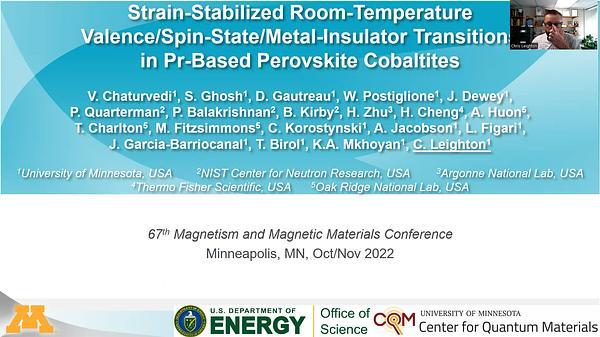Would you like to see your presentation here, made available to a global audience of researchers?
Add your own presentation or have us affordably record your next conference.
Ferrimagnets composed of two or multi antiferromagnetically coupled magnetic sublattices have attracted much attention recently due to the easily controlled and detected net magnetization and a fast magnetic dynamic behavior 1. Especially, ferrimagnetic thin films with perpendicular magnetic anisotropy (PMA) show great potential for high-density spintronics devices 2. Currently, most of work focus on the rare earth-transition metal ferrimagnetic alloys, such as GdFeCo and TbCo. However, the magnetization of these materials is sensitive to the temperature and composition 3. The antiperovskite Mn4N compound is a rare-earth-free ferrimagnet showing a PMA, high thermal stability, high spin polarization and low saturation magnetization which make it promising for practical spintronics devices 4.
For the crystalline structure of Mn4N compound, Mn atoms occupy the corners (MnA) and face-centers (MnB) of the cubic unit cell, respectively, while N atom is located at the body center, as shown in Fig. 1(a). The magnetic moment of MnA and MnB are antiferromagnetically coupled with a high Curie temperature, 740 K. PMA in Mn4N thin films had been observed by epitaxially depositing it on the MgO substrate. However, the large lattice mismatch between Mn4N and MgO, −6%, induces a misfit dislocation of Mn4N resulting in a poor PMA. In this work, by inserting a thin Pd buffer layer with a very close lattice constant of Mn4N, we prepared the stacks MgO(substrate)/Pd(t = 0, 2 and 8 nm)/Mn4N(80 nm)/Ta(3 nm). We systematically studied the effect of Pd buffer layer on the crystalline structure and magnetization of Mn4N thin films. With inserting a Pd buffer layer, a good quality of crystalline structure can be formed which significantly improves the PMA, as shown in Fig. 1(b).
References:
1 S. K. Kim et al., Nat. Mater. 21, 24–34 (2022)
2 B. Dieny and M. Chshiev, Rev. Mod. Phys. 89, 025008 (2017)
3 H. Bai et al., Adv. Electron. Mater. 8, 2100772 (2022)
4 Z. Zhang and W. Mi, J. Phys. D: Appl. Phys. 55 013001 (2022)

Fig. 1: (a) Crystalline structure of Mn4N. (b) Pd thickness dependence of magnetization of Mn4N under an external out-of-plane magnetic field.
